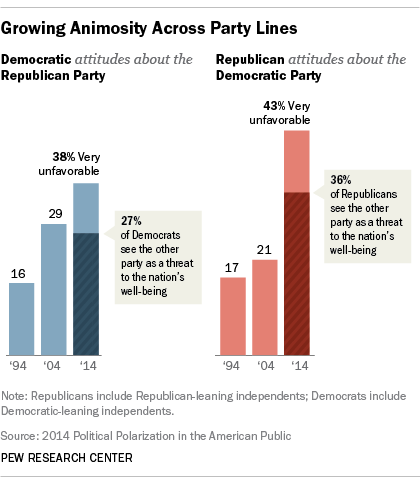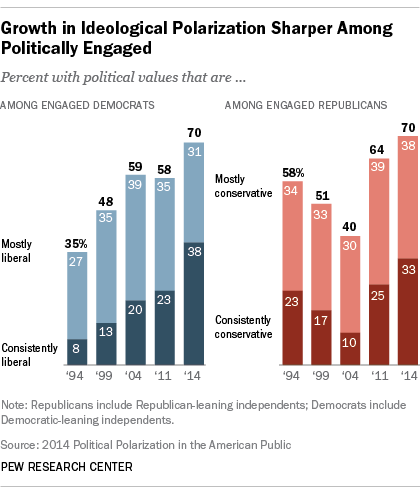Modern day media has reared its ugly head to make American politics more divisive than ever before. On the one hand, independent media has a more prominent presence which leads to new angles and ideas for those who actively seek them. The flipside is that the internet world is built to be an echo chamber of cognitive bias. Recent studies have shown that our pre-conceptions are not challenged on the web – rather, they get reinforced. Research from The Pew Research Center confirms that there is growing polarization of politics in the United States, with consensus opinions on both the left and right spreading further apart. All one has to do to seek proof of this? Take a look at the current outliers in the field of candidates that have announced their US presidential bids: a self-proclaimed democratic socialist, a libertarian-leaning Paul, and a (very) outspoken and often controversial real estate magnate confirm this to be true. As seen in the above animation, the share of Americans who express a consistently liberal or conservative views have doubled over the past two decades from 10% to 21%. The median positions, which used to overlap relatively closely, have spread much further apart such that the “typical” Republican is more conservative than 94% of Democrats. Two decades ago, this number was only 70%. Further, there is more hate and blame being passed around these days:
It is now true that 43% of Republicans have “very unfavorable” attitudes about the Democratic Party, and 36% of Republicans even go so far as to say that the blue party is a threat to the nation’s well-being. The feelings are mutual on the other side of the aisle as well, with 38% of Democrats having “very unfavorable” attitudes towards Republicans. This animosity of people surveyed has more than doubled since 1994. The most ideologically polarized Americans are those that are more engaged in the political process:
Those that were “consistently” or “mostly” liberal or conservative in their views tended to be those that also considered themselves to be politically engaged. While the polarization of politics in America seems greater than before, the good news is that the addition of people like Donald Trump, Rand Paul, and Bernie Sanders to the conversation may help for an escape from the usual carefully-refined rhetoric. Getting politicians outside of their comfort zones is a small win for everyone, and it will at least provide for new ideas along with some popcorn munching styled entertainment. Original graphics by: Pew Research on Even while political regimes across these countries have changed over time, they’ve largely followed a few different types of governance. Today, every country can ultimately be classified into just nine broad forms of government systems. This map by Truman Du uses information from Wikipedia to map the government systems that rule the world today.
Countries By Type of Government
It’s important to note that this map charts government systems according to each country’s legal framework. Many countries have constitutions stating their de jure or legally recognized system of government, but their de facto or realized form of governance may be quite different. Here is a list of the stated government system of UN member states and observers as of January 2023: Let’s take a closer look at some of these systems.
Monarchies
Brought back into the spotlight after the death of Queen Elizabeth II of England in September 2022, this form of government has a single ruler. They carry titles from king and queen to sultan or emperor, and their government systems can be further divided into three modern types: constitutional, semi-constitutional, and absolute. A constitutional monarchy sees the monarch act as head of state within the parameters of a constitution, giving them little to no real power. For example, King Charles III is the head of 15 Commonwealth nations including Canada and Australia. However, each has their own head of government. On the other hand, a semi-constitutional monarchy lets the monarch or ruling royal family retain substantial political powers, as is the case in Jordan and Morocco. However, their monarchs still rule the country according to a democratic constitution and in concert with other institutions. Finally, an absolute monarchy is most like the monarchies of old, where the ruler has full power over governance, with modern examples including Saudi Arabia and Vatican City.
Republics
Unlike monarchies, the people hold the power in a republic government system, directly electing representatives to form government. Again, there are multiple types of modern republic governments: presidential, semi-presidential, and parliamentary. The presidential republic could be considered a direct progression from monarchies. This system has a strong and independent chief executive with extensive powers when it comes to domestic affairs and foreign policy. An example of this is the United States, where the President is both the head of state and the head of government. In a semi-presidential republic, the president is the head of state and has some executive powers that are independent of the legislature. However, the prime minister (or chancellor or equivalent title) is the head of government, responsible to the legislature along with the cabinet. Russia is a classic example of this type of government. The last type of republic system is parliamentary. In this system, the president is a figurehead, while the head of government holds real power and is validated by and accountable to the parliament. This type of system can be seen in Germany, Italy, and India and is akin to constitutional monarchies. It’s also important to point out that some parliamentary republic systems operate slightly differently. For example in South Africa, the president is both the head of state and government, but is elected directly by the legislature. This leaves them (and their ministries) potentially subject to parliamentary confidence.
One-Party State
Many of the systems above involve multiple political parties vying to rule and govern their respective countries. In a one-party state, also called a single-party state or single-party system, only one political party has the right to form government. All other political parties are either outlawed or only allowed limited participation in elections. In this system, a country’s head of state and head of government can be executive or ceremonial but political power is constitutionally linked to a single political movement. China is the most well-known example of this government system, with the General Secretary of the Communist Party of China ruling as the de facto leader since 1989.
Provisional
The final form of government is a provisional government formed as an interim or transitional government. In this system, an emergency governmental body is created to manage political transitions after the collapse of a government, or when a new state is formed. Often these evolve into fully constitutionalized systems, but sometimes they hold power for longer than expected. Some examples of countries that are considered provisional include Libya, Burkina Faso, and Chad.















